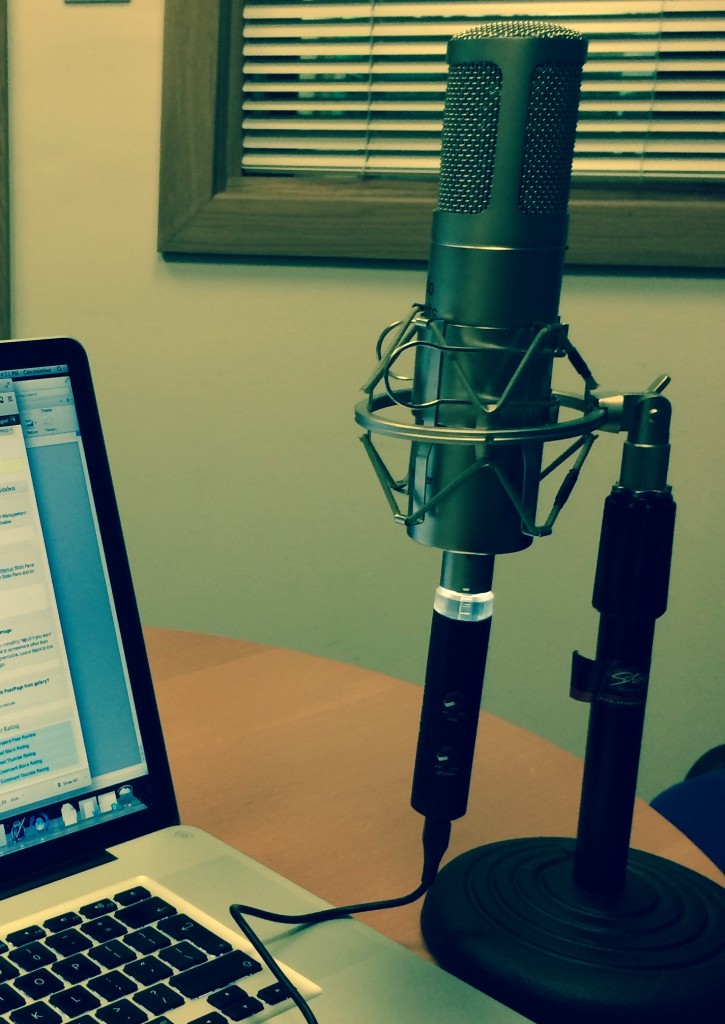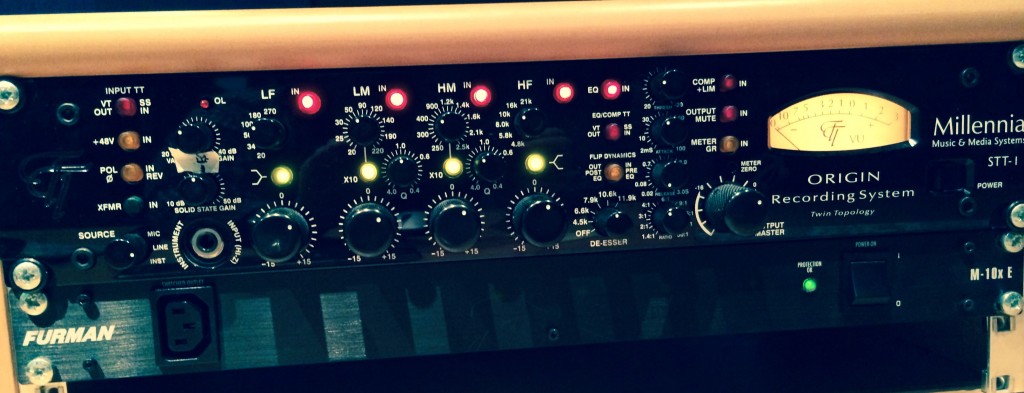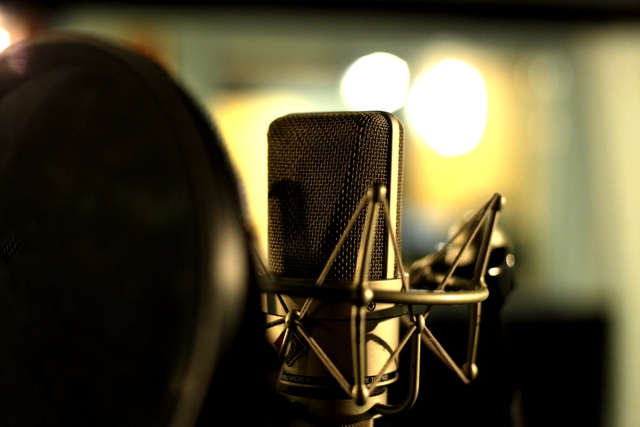Choosing a preamp to go with your microphone is every bit as important as choosing the microphone itself. So what’s the best way to go about it?
But first and foremost, why is a preamp needed? It’s often said that to reach industry-standard professional sound voice-overs you need to invest 50% in a good mic and the other 50% in a good preamp. The microphone preamp usually comes preinstalled within a conventional digital mixer. As all preamps it provides the 48V DC phantom power needed to amplify the audio signal coming from a condenser mic. However the quality of these embedded preamps might not really good enough for a professional use in case you have a cheap condenser mic (under $ 300) with low output signal. Plus this incorporated circuit sometimes has the inconvenience of introducing some electronic noise in the audio signal before it’s actually converted into a digital format.
So we think that the best option is to buy an outboard preamp. For voice-overs you can start with the portable MicPort Pro, very handy and cost-effective ( $ 180). It can be plugged to a computer USB port. It provides phantom power, gain level and a useful inlay to plug your headphones and hear your recording without latency. I know people who use the MicPort Pro with tablets that have USB power.
However if you want to move up in quality, then you should consider a channel strip that includes a simple EQ processor, a De-esser and a Compressor, but these are features that can also be used with your software (Sound Forge, ProTools, etc). Let’s consider this possibility of a decent outboard preamp.

YOU CAN USE MICPORT PRO, AN AFFORDABLE OPTION IDEAL FOR A HOME STUDIO

IF YOUR STUDIO IS NOT A ONE-MAN-SHOW, BUT A PROFESSIONAL ONE, THINK ABOUT A MILLENNIA OR AN AVALON
Here are some tips for a preamp:
- Keep things simple and don’t overspend. Choose a preamp that is easy to use with a single or dual channel that gives you high gain and a clean and crisp signal. If you want warm tones, then get one with a valve.
- Having EQ and Compression in your preamp is great but you don’t really need one with lots of different processing features. There is a danger that you can produce recordings which are over-processed or become distorted. Unless you are a qualified studio engineer and understand all the processing features then it’s best to steer clear.
- Producing a recording that is clean, clear, with no distortion and now noise is what you want from your preamp. Leave any other processing adjustments to the engineers.
- Do some research online and then visit your local audio store and test your microphone with the various preamps that they have and see what sounds best. Listen out for the clarity and the warmth that it gives your voice. You want a microphone and preamp combination that presents your voice loudly and clearly without having to turn the gain up too high.
There are numerous options, styles and features to choose from when selecting a preamp and these cover a wide price range. As with microphones there are no hard and fast industry standards for preamps but there are some great choices out there from manufacturers like Avalon, Focusrite, Millennia and Schoeps. If you want to have a look at the best options available check out the blog page from Mixwerk a German company.
But all you wanted to know about preamps but you didn’t dare ask can actually be found at this superb buying guide from Musiciansfriend.
Getting the microphone and preamp combination correct is key to producing a quality sound so it pays to shop around and find a combination that works for you. Another option is just investing more on top-notch condenser mic that comes with an adapted preamp box.What preamp do you use?
Have you got any other tips that you would like to share? Please let us know.

Timely advice, as ever. Having spent some time driving down environmental noise – mechanical boiler-hum was the challenge -my lineup still has a slight 100Hz (UK mains) electrical hum. It comes from the mic-pre, which is part of a channel strip.
At about minus 95 unweighted on a spectrum display you don’t hear it unless you play back absurdly loud, but it is THERE.
I have a voice colleague whose ‘room tone’ is absolutely innocent of hum – and indeed she chose her preamp with care, aware that a certain audiobook publisher would put auditions through their analyser before awarding work!
CONSTANTINO,
Spot on! I use two mic’s:
Bock 241, Sennhieser 416
both go into an Avalon AD2022
Best part is your section on not overdoing EQ & processing. The only reason I use any, is to adjust for the room or booth I’m in. And these are very MINOR adjustments. Other than that, I send my auditions/work in clean.
If you don’t, if one gets to do a ISDN VO session of any magnitude, you will here the audio engineers on the other end telling you to “remove” any processing you have.
PS: I also use the Micport Pro for my mobile system…for the money, this little Pre is like gold!
Many thanks!
Jerry Pelletier
True all Constantino! I added a preamp to my first mic and suddenly realized what all the fuss was about. Now I use a CAD E100S coupled with this RIDICULOUS Warm Audio WA12 preamp. As for Channel strip style pre’s I’d say the ART Voice Strip is probably one of the best choices. I wouldn’t trade the CAD/WA12 combo… It rocks for me and my customers love it.
Hello Constantino,
thanks for this new post. On my side, I use U87 mic and sometimes C414 or SM7, always with my Focusrite Red 7 preamp (a fine combination that work well for me). As Jerry, I always send my work without effect/process. I only activate limitor (in fact compressor with high rate and high threshold) only to avoid clip on some energetic takes.
Remy
These days I’m inclined to suggest MicPort Pros and call it good (plural for backups). …anything else gets really complicated. I have multiple, super-high-end preamps and find the MicPort Pro to be more than adequate.
However, modern preamps don’t have the poop to support low-output mics like passive ribbons, or broadcast dynamics like an RE20, SM5, or SM7.
I use an inline booster called a CloudLifter.
I do not agree that matching a mic to a preamp is imperative as long as the devices work together. If you match a good mic with a good pre, then you’ll get a good sound – although – individual preference may vary.
I absolutely agree that VOs should produce clean, dry tracks – nothing more – unless they have a lot of production experience.
Good item…
Mike Holmes
Owner of Mike Holmes Radio
I had an Avalon 737 and Great River ME1-NV, two of the most popular pre’s, at $2000 and $1100 respectively. Then I found out about Peter Montessi’s company, A Designs, and their P1 mic pre (a 500 series piece of gear, read up on it if you’re not familiar with the genre). I use a Lawson L47-MPII, one of the world’s great VO microphones. I had used it several years before discovering the P1. Few pieces of gear really strut their stuff right out of the box. The P1’s effect was startling from the first sentence.
I used it several months and during that time did not hear any tracks I’d recorded before I got it. One day I chanced to play such a track, and was astonished to hear a displeasing midrange hump jump out at me. I couldn’t believe I hadn’t heard it before, and the P1 had smoothed it into nothingness.
Reviews:
http://www.gearslutz.com/board/reviews/715333-designs-p1-500-series-mic-pre-di.html (scroll down for user reviews)
And from: http://www.musicarts.com/A-Designs-P1-Single-Channel-Microphone-Preamp-Module-189906-i1125446.mac, this:
“In solid-state preamp design, the key to a big punchy sound rests in the input and output transformers. (That’s where you get what is known as the “big iron” sound of the ’70s). To ensure top-quality sound, A Designs has their transformers custom-built by Tom Reichenbach of Cine-Mag, whose lineage extends back the days when his father Ed built transformers for Altec-Lansing in the ’40s. Not only are the transformer hand-made, they’re also “ear-made” by Jon (who spent years rebuilding vintage gear for LA studios), and Peter (longtime LA musician and preamp guru), who won’t okay a transformer design until they get exactly the sound they’re looking for. With the A Designs P1, you can put those ears and 60 years of combined experience to work for you and bring your recordings to new sonic heights.” I got mine from SoundPure.com.
I am in the process of building a voiceover home recording studio and I’m looking for some advice. I have researched and researched online looking for the best microphone / mic preamp combination, I had settled on a Neumann TLM 103 and was searching for the right preamp for that microphone and came across to many varying opinions about that microphone…..good and bad. I have done in-studio voice over work in the past and I’m looking to build a home studio capable of providing quality voiceover work, my budget for a microphone and a preamp is $2000 or less, I will be using it on a new iMac with Logic ProX. Also I have a vintage Telefunken microphone that I’m looking to help determine what model it is if there are any collectors out there who might know what it is or be interested in it, I can send a picture.
The Avalon is the best, but if your budget is low, you can choose any preamp over 500 USD. What makes the difference here is your mike, and your choice is fine.
Thanks Constantino, I have been looking in the $600 to $800 range, depending on the microphone I choose. I have been doing a lot of research and I’m torn between three microphones the TLM 103 with A very inexpensive preamp, a CAD E100S or Harlan Hogan VO1-A with something like a UA 710 Twinfinity, i’m not sure whether to invest in a microphone and make do with an inexpensive preamp until I can afford a better one or to get a middle-of-the-road microphone with a decent preamp and invest in a quality microphone down the road. I have read a lot of good reviews about the CAD E100 S and Harlan Hogan microphone I just want to make sure they are pro quality enough to get work and maintain clientele. I have also read a lot of good reviews about the TLM 103 but also saw a fair amount of negative reviews on it and if I invest $1000 in a microphone I will have to go cheap on the preamp.
Hi Craig,
What preamp you have now?
Your audio card have phantom power for mic?
Best Regards
I am in the process of buying all the equipment to set up my studio the computer I was going to purchase is as follows:
Apple 27″ iMac
3.5GHz Quad-core Intel Core i7, Turbo Boost up to 3.9GHz
16GB 1600MHz DDR3 SDRAM – 2X8GB
1TB Serial ATA Drive @ 7200 rpm
NVIDIA GeForce GTX 775M 2GB GDDR5
I couldn’t find any info about the sound card, I have a Tascam USS 122 interface I will use for music but My total budget is around $4000 I know I want a Mac wasn’t sure about a laptop or desktop and then my previous questions about the microphone and preamp….I plan on building a vocal booth next month and upgrading equipment down the road, buying more mic’s, preamp, etc, I am trying to determine what is the best equipment to start out with for doing a demo tape and getting started, but want pro quality as much as possible for my budget.
Your configuration should be as follows: Apple PC + Tascam 122 interface, you don’t need any audio card. You just connect the Tascam to the USB port of your computer. Your process the audio using your preferred software, we recommend ProTools so that you can record to pictures. Then use a good mic (the TLM 103 is a good option). But first and foremost, acoustics is key to success. Sound proofed booth is essential.
My Tascam USS 122 is older, not the MKII but it has phantom-powered mic preamps, I just assume it isn’t sufficient for my purposes. Would it be okay to use the USS 122 to make a “pro-sounding” demo, audio quality wise, not talent wise? I would then invest in a 737 or other mic-pre within a year, if so I would probably then lean toward the TLM 103 as opposed to the CAD E100-S or HH VO1 mic I think?
Many times in the past used a preamp from Universal Audio 710, with Belden and Mogami cables, and used a Akg c4000b. Customers loved the sound … but the studios do not. Whenever i call to a German studio by SE Source Connect, they say that I did not have enough gain , and that i am having background noise (things I had not)…
Now i am Alternating my recordings with a microphone from Oktava 105, AKG c4000b, Sontronics sct 2, and MXL 990s.
Amazingly, customers (European and Japanese studios) prefer the sound of the Oktava 105 or Sontronics, instead of the other.
For long narrations i use a Senheiser md441u, who needs a Cloudlifter, to have a decent sound .Now my UA710 is with a friend who complains of some noise of static … (made in China as you know).
Currently i am avoiding to buy products made in China, because i do not believe in quality control. If it were now …i would preferred a Sontronics Sonora 2 (made in the UK) or an SPL Goldmike (made in Germany), because the quality is obviously different.
Nowadays I connect directly my microphone to my A / D converter of the brand Tascam US200, which proved to be one of the best converters price vs quality. (better than my previous Scarlet 2i2). Greetings from Europe